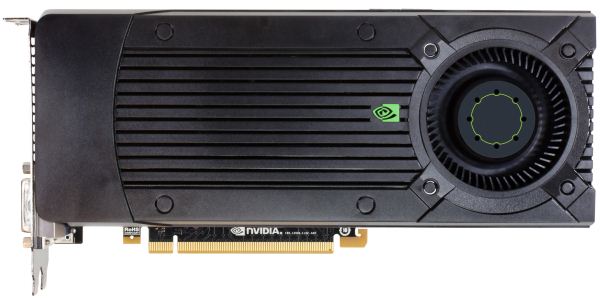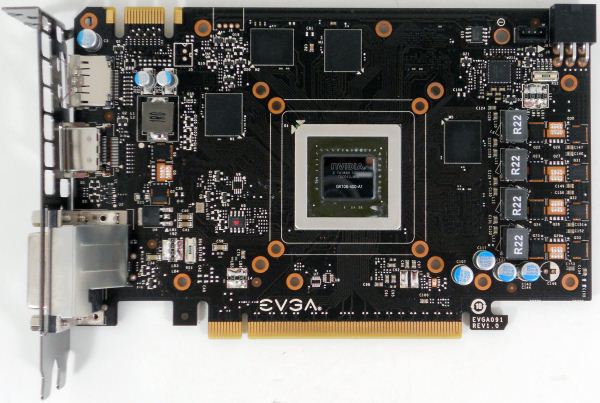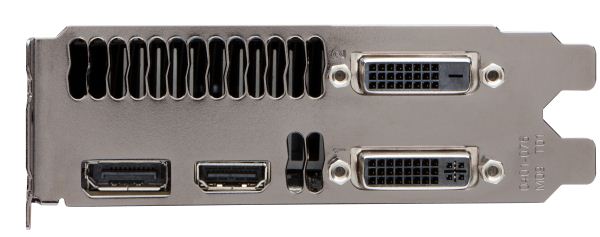The NVIDIA GeForce GTX 660 Review: GK106 Fills Out The Kepler Family
by Ryan Smith on September 13, 2012 9:00 AM ESTMeet The GeForce GTX 660
For virtual launches it’s often difficult for us to acquire reference clocked cards since NVIDIA doesn’t directly sample the press with reference cards, and today’s launch of the GeForce GTX 660 launch is one of those times. The problem stems from the fact that NVIDIA’s partners are hesitant to offer reference clocked cards to the press since they don’t want to lose to factory overclocked cards in benchmarks, which is an odd (but reasonable) concern.
For today’s launch we were able to get a reference clocked card, but in order to do so we had to agree not to show the card or name the partner who supplied the card. As it turns out this isn’t a big deal since the card we received is for all practical purposes identical to NVIDIA’s reference GTX 660, which NVIDIA has supplied pictures of. So let’s take a look at the “reference” GTX 660.
The reference GTX 660 is in many ways identical to the GTX 670, which comes as no great surprise given the similar size of their PCBs, which in turn allows NVIDIA to reuse the same cooler with little modification. Like the GTX 670, the reference GTX 660 is 9.5” long, with the PCB itself composing just 6.75” of that length while the blower and its housing composes the rest. The size of retail cards will vary between these two lengths as partners like EVGA will be implementing their own blowers similar to NVIDIA’s, while other partners like Zotac will be using open air coolers not much larger than the reference PCB itself.
Breaking open one of our factory overclocked GTX 660 (specifically, our EVGA 660 SC using the NV reference PCB), we can see that while the GTX 670 and GTX 660 are superficially similar on the outside, the PCB itself is quite different. The biggest change here is that while the 670 PCB made the unusual move of putting the VRM circuitry towards the front of the card, the GTX 660 PCB once more puts it on the far side. With the GTX 670 this was a design choice to get the GTX 670 PCB down to 6.75”, whereas with the GTX 660 it requires so little VRM circuitry in the first place that it’s no longer necessary to put that circuitry at the front of the card to find the necessary space.
Looking at the GK106 GPU itself, we can see that not only is the GPU smaller than GK104, but the entire GPU package itself has been reduced in size. Meanwhile, not that it has any functional difference, but GK106 is a bit more rectangular than GK104.
Moving on to the GTX 660’s RAM, we find something quite interesting. Up until now NVIDIA and their partners have regularly used Hynix 6GHz GDDR5 memory modules, with that specific RAM showing up on every GTX 680, GTX 670, and GTX 660 Ti we’ve tested. The GTX 660 meanwhile is the very first card we’ve seen that’s equipped with Samsung’s 6GHz GDDR5 memory modules, marking the first time we’ve seen non-Hynix memory on a GeForce GTX 600 card. Truth be told, though it has no technical implications we’ve seen so many Hynix equipped cards from both AMD and NVIDIA that it’s refreshing to see that there is in fact more than one GDDR5 supplier in the marketplace.
For the 2GB GTX 660, NVIDIA has outfit the card with 8 2Gb memory modules, 4 on the front and 4 on the rear. Oddly enough there aren’t any vacant RAM pads on the 2GB reference PCB, so it’s not entirely clear what partners are doing for their 3GB cards; presumably there’s a second reference PCB specifically built to house the 12 memory modules needed for 3GB cards.
Elsewhere we can find the GTX 660’s sole PCIe power socket on the rear of the card, responsible for supplying the other 75W the card needs. As for the front of the card, here we can find the card’s one SLI connector, which like previous generation mainstream video cards supports up to 2-way SLI.
Finally, looking at display connectivity we once more see the return of NVIDIA’s standard GTX 600 series display configuration. The reference GTX 660 is equipped with 1 DL-DVI-D port, 1 DL-DVI-I port, 1 full size HDMI 1.4 port, and 1 full size DisplayPort 1.2. Like GK104 and GK107, GK106 can drive up to 4 displays, meaning all 4 ports can be put into use simultaneously.














147 Comments
View All Comments
Galidou - Thursday, September 20, 2012 - link
Whenever I see CeriseCogburn commenting, Chizow is not, and vice versa....If you never heard about price fixing, sorry for you but it's a fact, THAT is a fact, people don't have to beleive in that, it's happening right now and always has been and beleive me it will continue, because almost every company in the world is greedy even if it means communicating with the competition to maximize profit....
CeriseCogburn - Thursday, November 29, 2012 - link
Gal, you silly gal, Chizow knows a lot more than I do, but I'll say this, you're an insane and incorrect amd fanboy of the worst kind.I hope david's butt remains a delicacy to you, even after the corpse is buried, which is, by the way, to happen, very soon.
CeriseCogburn - Thursday, November 29, 2012 - link
Galidou, you win NOTHING for being a lying sack, then whining when someone is so sick of your complete bs, they offend your idiot retarded estrogen doused amd licking being because they aren't a sick lying gasbag biased amd pig.Glad that religious Bible story has you kissing david amd's tokus furiously though, as that surely commands respect.
LOL
NOT !
Oh, were you insulted ?
Let's hope so, because of course, you tell so many lies, it's IMPOSSIBLE for you to not be insulted.
rarson - Tuesday, September 18, 2012 - link
AMD's pricing doesn't need to be defended because anyone with a grasp of basic economics can easily understand why they priced them the way they did. That's why most people are ignoring your inane and mind-bogglingly stupid comments."How do you feel now about those $550, $450, and $350 pricepoints you so vigorously defended when the 7970/7950/7870 launched?"
Absolutely fine, dumbass, because it's September now. Duh.
"So just as I asked then"
Nobody cares, dude. Go fanboy somewhere else.
chizow - Tuesday, September 18, 2012 - link
Yes anyone with a basic grasp of economics would never have defended the worst increase in price and performance in the last decade and then be OK with the biggest price drop in the least amount of time within the same generation. AMD now holds the notorious distinction for both and their fanboys (like you) get to suffer the consequences.How much did the GTX 580 cost 15 months after release? $500 still dumbass, duh, now go fanboy somewhere else? Parts like this don't lose their value unless they suck, or their pricing sucks, or both, but obviously you're too oblivious or stupid to realize this, or maybe you're just accustomed to it as an AMD fan.
CeriseCogburn - Thursday, November 29, 2012 - link
You're an idiot.AMD cost me plenty, and I will NEVER fall for your stupid amd lies, ever again.
Klimax - Saturday, September 15, 2012 - link
A thing: Dirt Showdown is AMD game using DC codepath optimised ONLY for Radeons severly penalising nVidia's cards. It is not valid for any comparsions.(At least not with that option enabled)
chizow - Thursday, September 13, 2012 - link
Just wondered if there was any news about price drops for higher-end SKUs. It becomes more obvious with every newly released SKU that the original asking prices from both AMD and Nvidia on 28nm parts were far too high. $350 for a 7870 looks like a complete debacle at this point given a $229 part outperforms it just a few months later.Also it looks like the Summer 2012 GPU pricing chart needs to be adjusted for the GTX 660 (it shows $239).
Thanks for the commentary on page 3 about Nvidia's Competition. Much like Intel, they still need to compete with themselves to entice owners of their previous products to upgrade. I'm glad someone else gets it, its pretty obvious Nvidia does as well. I guess they heard the complaints of all their enthusiasts when asking $500 flagship dollars for a part based on a midrange ASIC.
RussianSensation - Thursday, September 13, 2012 - link
A couple months?HD7850 - $249 March 3, 2012
HD7870 - $349 March 3, 2012
GTX660 - $229 September 13, 2012
It's been 7 months.
Someone who bought an HD7850 and OCed it enjoyed ~ GTX580 / HD7950 level of performance for 7 months now. Using the same exact logic you have just outlined, then we should recommend people to wait 7 more months for HD8000 series and skip GTX660 because for them the 660 would be an "early adopter" premium vs. HD8870. See how illogical your comment is?
GPUs often drop in price over time as the generation goes on.
Interesting how GTX280 for $649 and GTX260 $399 weren't a problem for you.
chizow - Thursday, September 13, 2012 - link
Except we've already covered this pricing debacle months ago, pretty sure you were onboard then, what happened since then?The 7870 was already vastly overpriced because it offered 6970/GTX 570 at.....6970 and GTX 570 prices. Parts that were already widely available for at least 20 months prior to the 7870's launch at the exact same prices. Anyone who already had that performance level would have no incentive to sidegrade to a 7870 at that pricepoint.
What is obvious now as it was then is that there was no movement in terms of price:performance that you would expect from a new generation, the metric didn't shift at all for 28nm until Kepler launched. Now that Kepler has finally trickled down to this performance level, its that much more clear. Bringing your 8870 argument into the fold, I wouldn't agree with that view either as I would expect the 8870 to offer more performance at a lower pricepoint, not the same performance at the same price as is the case with the 7870 at launch.
I don't know why you're trying to defend AMD's horrid 28nm pricing but the fact of the matter is, the current pricing structure is really what 28nm should have been from the outset, anyone who bought in March and didn't actually need a new GPU is undoubtedly feeling the burn of all the recent price drops, but hey, at least its not as bad as Facebook's IPO?
And no, GTX 260/280 weren't a problem for me because the difference is with those parts, the performance justified the premium relative to the last generation of cards (8800GT/GTX). This generation clearly does not adhere to those same expectations, which again, is a view I'm pretty sure you were onboard with months ago. What Nvidia didn't expect was for AMD to lowball them so much on a certain performance level, something AMD has clearly worked to remedy with each successive generation with their increases in asking prices for their 1st and 2nd tier single-GPU SKUs.